Francesca and Henk-Jan's Backpacking Trip!
Wednesday, April 21, 2010
The Ancient City Of Hue
On the 21st of April Henk and I began to explore Hue, Vietnam. While the town’s name looks like it is pronounced “Hyou” we quickly learned it was actually “Hway” instead. The night before Henk had run down to reception and asked them to book us on a city tour for the next morning. This tour was supposed to be really comprehensive, taking us to basically every interesting spot in the city in just one day. And cheap too! The day started around 8:00 AM with us driving a few loops around the city center to pick everyone up. Finally we were on our way, stopping first at the Imperial City.
Hue used to be the capital of Vietnam and the Imperial City was its palace. A walled city fortress, this area was surrounded by a boat and included the “Purple Forbidden City,” the area dedicated to housing the Nguyen royal family. The wiki can better explain some of the background of the city:
“It was in 1802 that Nguyễn Phuc Anh took control of Vietnam and proclaimed himself Emperor Gia Long. His rule was recognized by China in 1804...(A sidenote from me: The building of the Imperial City started in 1804, finished in 1833, and the city served as the center of government until 1945)… The American bombing in 1968 in response to a communist takeover of Hue flattened most of the Imperial city. Only a few buildings survived, such as the Thai Hoa Temple, Can Thanh Temple, The Mieu, and Hieu Lam Cac.”
We walked with our guide to see some of the few surviving buildings that withstand American bombs. He informed us that there are three parts to the old city: the Citadel, the Imperial City, and the Forbidden Purple City. There were also 5 entrances to the city: the middle for the king, the left for ministers, the right for military, and some further entrances for elephants. We started our exploration by walking through the Noon Gate. Upon walking closer to the buildings I noticed that many of the roof tops were decorated with a detailing of awesome faux gold coins that I just loved.
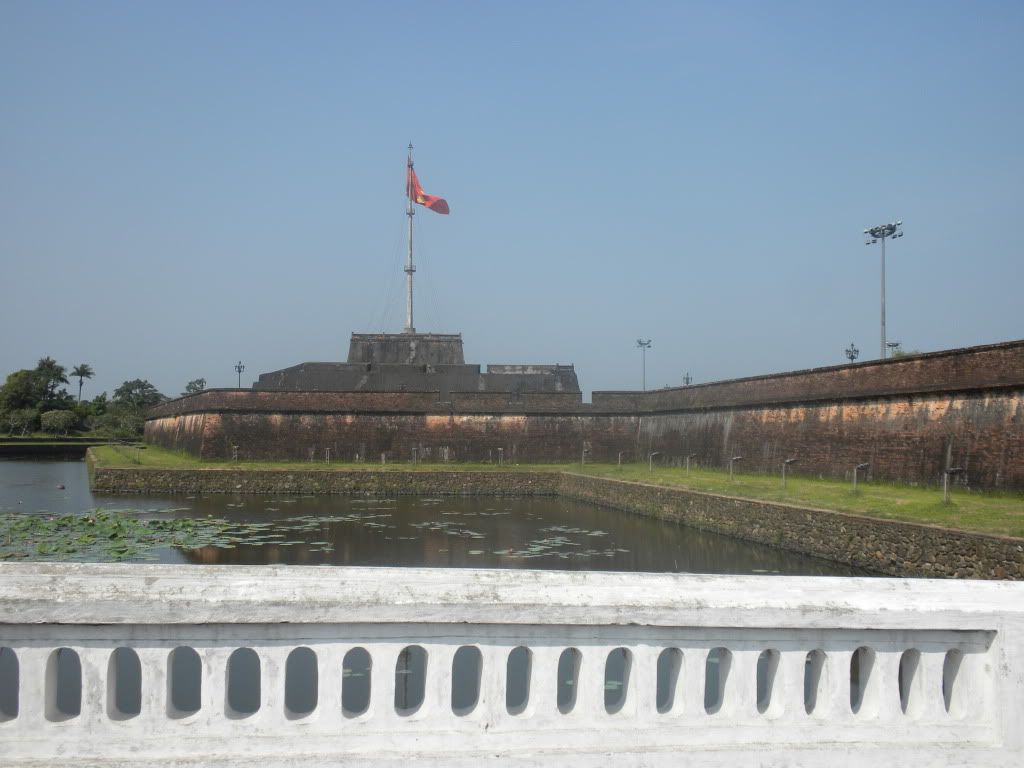
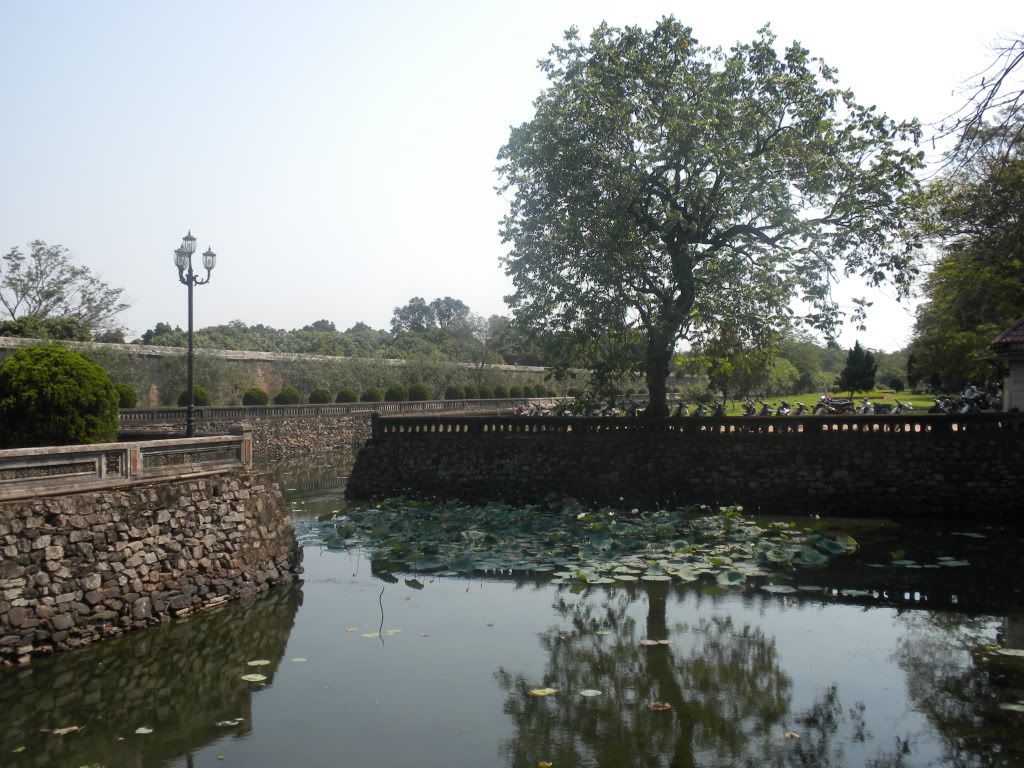
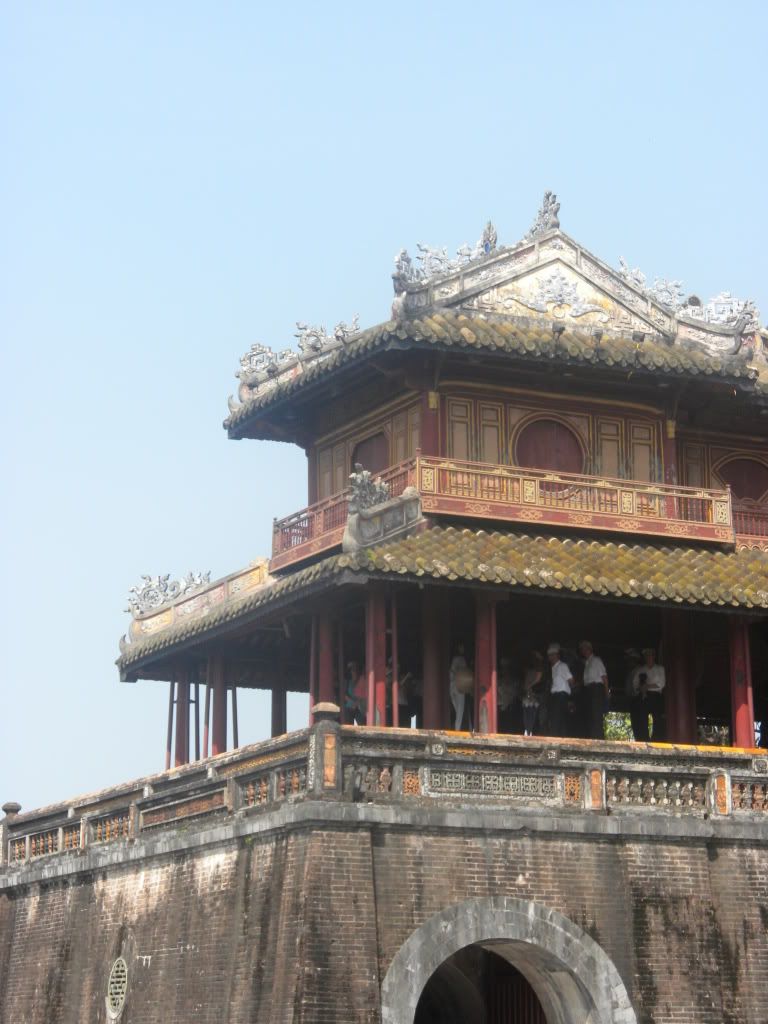
The Thai Hoa Palace area contained the king’s throne and was very pretty, decorated in red and gold. This palace area was where, according to the display plaques, the king held audiences of the Nguyen court and where he presided over ceremonies. Chinese poems were written on the walls. Many of these poems described the 4 powerful animals: the Dragon (representing the king), the phoenix (representing beauty), the turtle and the unicorn. We also looked at the throne, which is made of gold and thus very fragile and valuable.
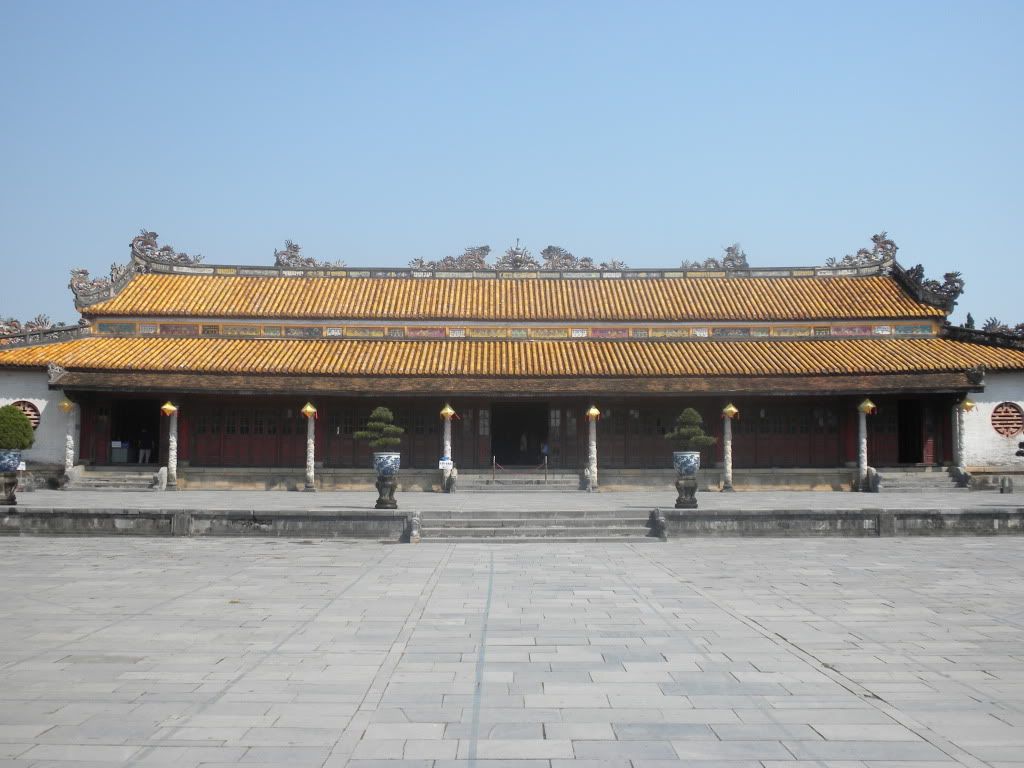
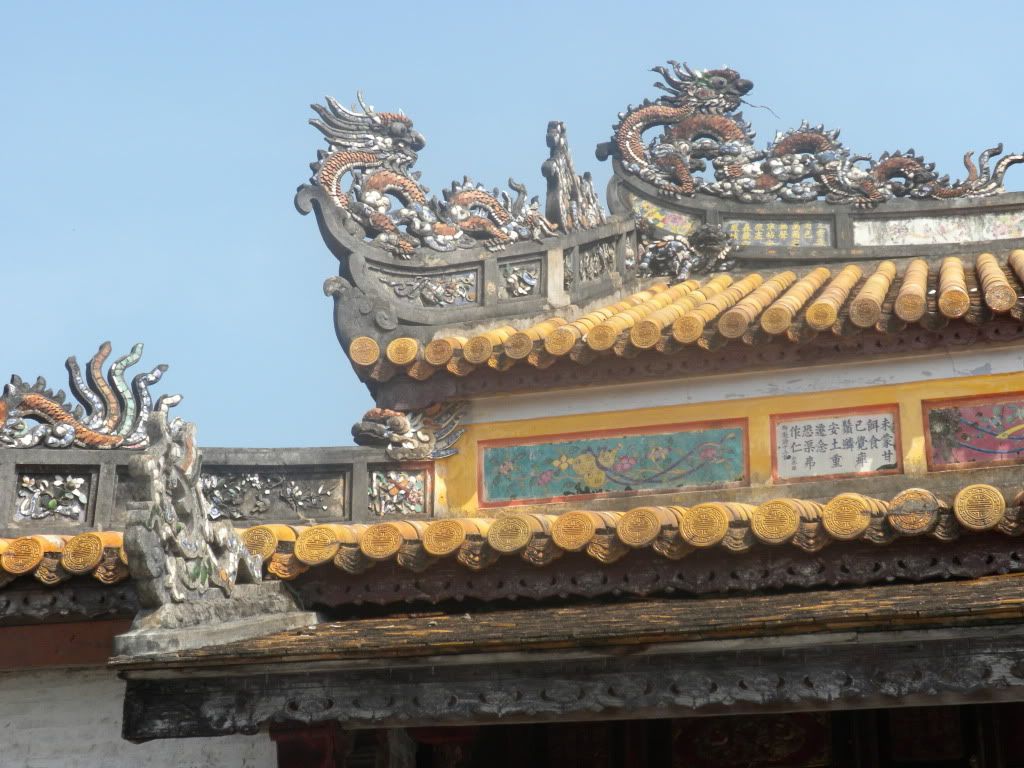

Exiting this area, we paused for a few minutes to watch a short video on the area, showing the digitized images of what the city would have looked like if it was still standing. Next we did a quick tour of the mandarin’s offices on the left and right of the pavilion. These buildings had been used as administrative offices, national exam halls, and banquet rooms. One of the office areas is now used as a mini-museum displaying some of the artifacts from the times. It was extremely sad to walk further and see the reconstruction area towards the back of the complex -- so much work to do and so much of the original buildings lost.
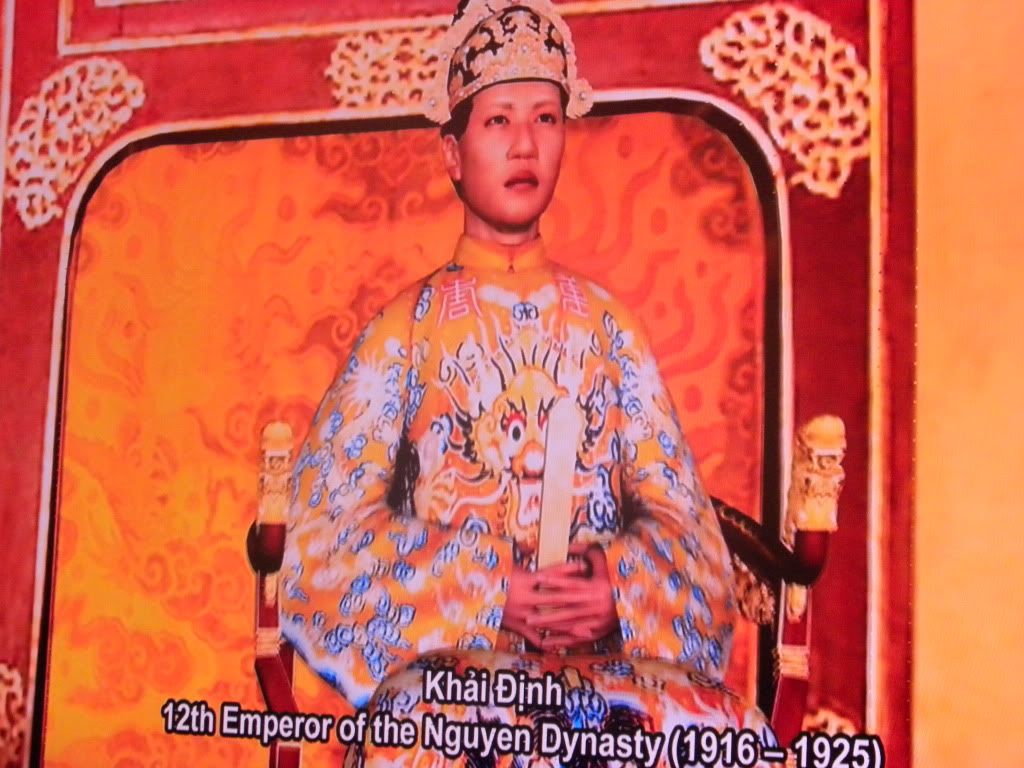
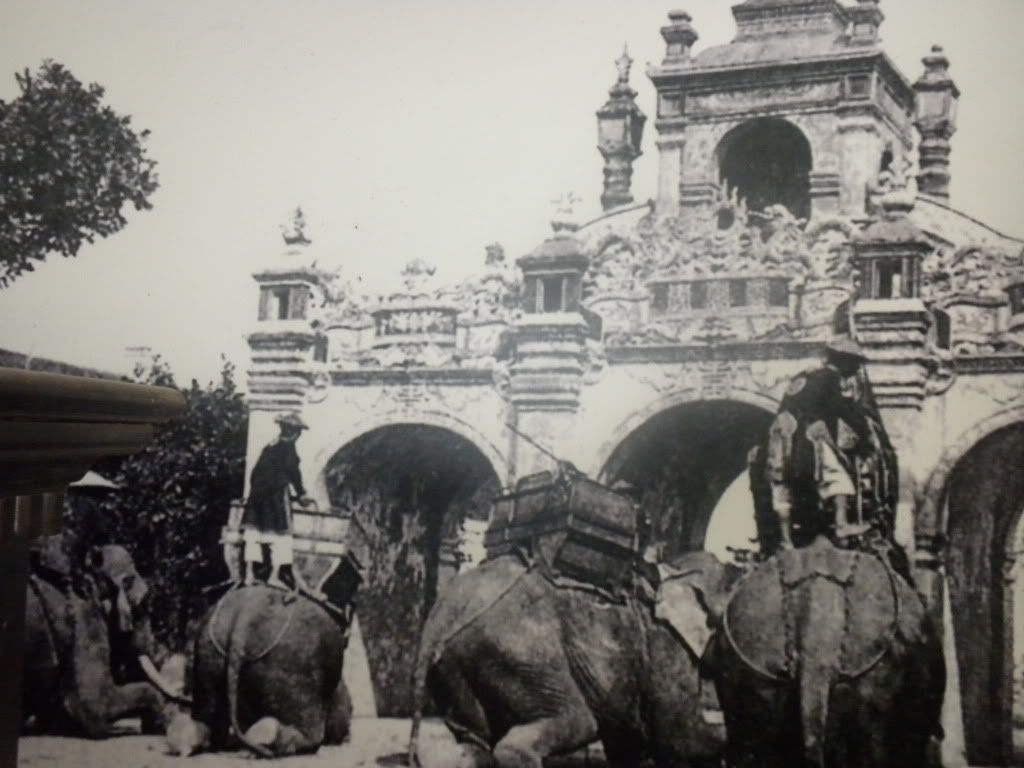
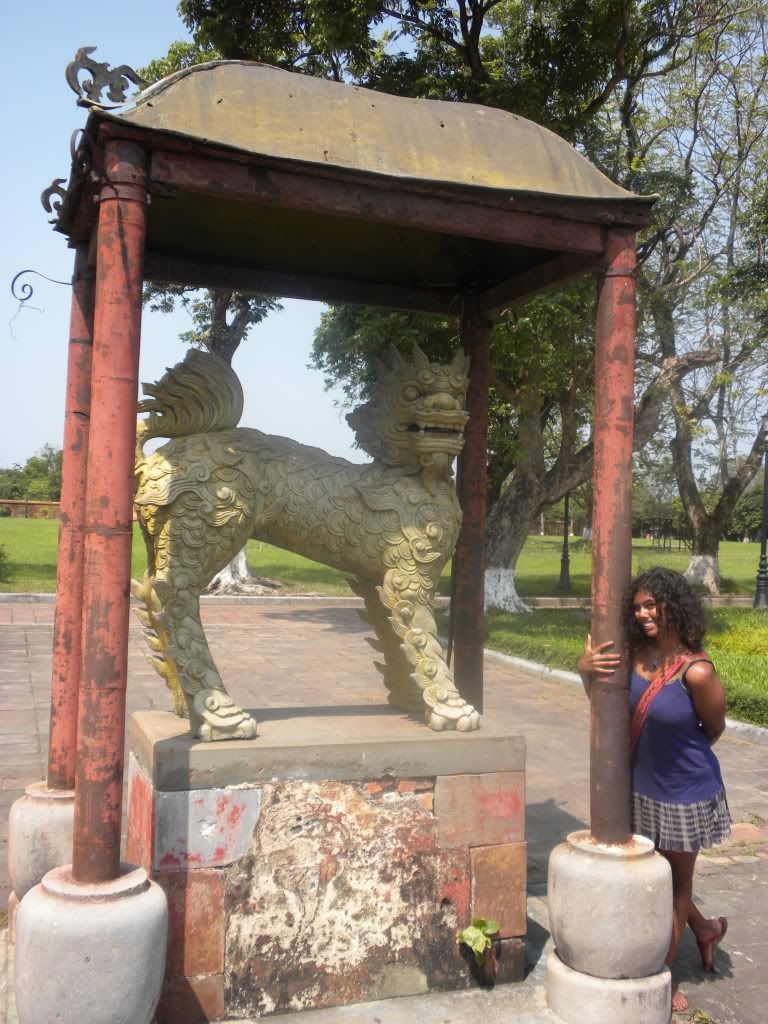
After the city we had a short break of tea and snacks before heading to our next stop. After learning about the mandarins who served the king, we were now going to visit one of their former houses. The house itself proved very sturdy, made of ironwood which helps to keep spiders away (don’t ask me how, something to do with the smell they don’t like) and makes the whole place look very elegant and formal. The family alter in the center of the house was the first thing we saw entering the house, and that area combined with the beauty of the gardens outside turned the whole place into a calm oasis in the middle of Hue.
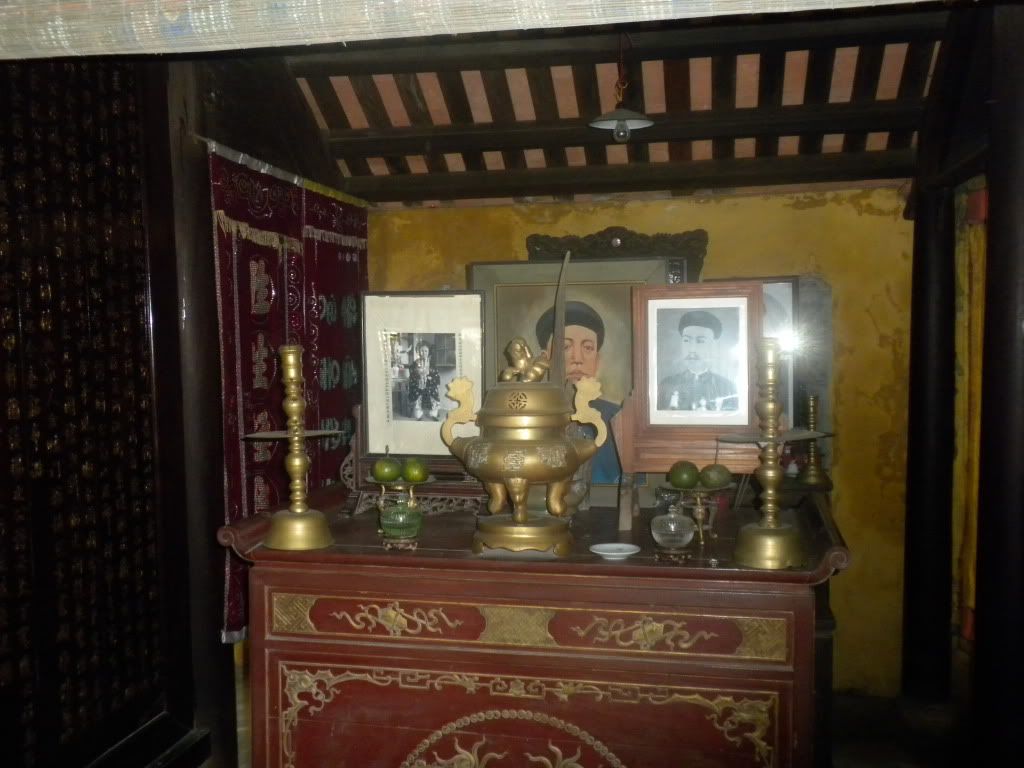
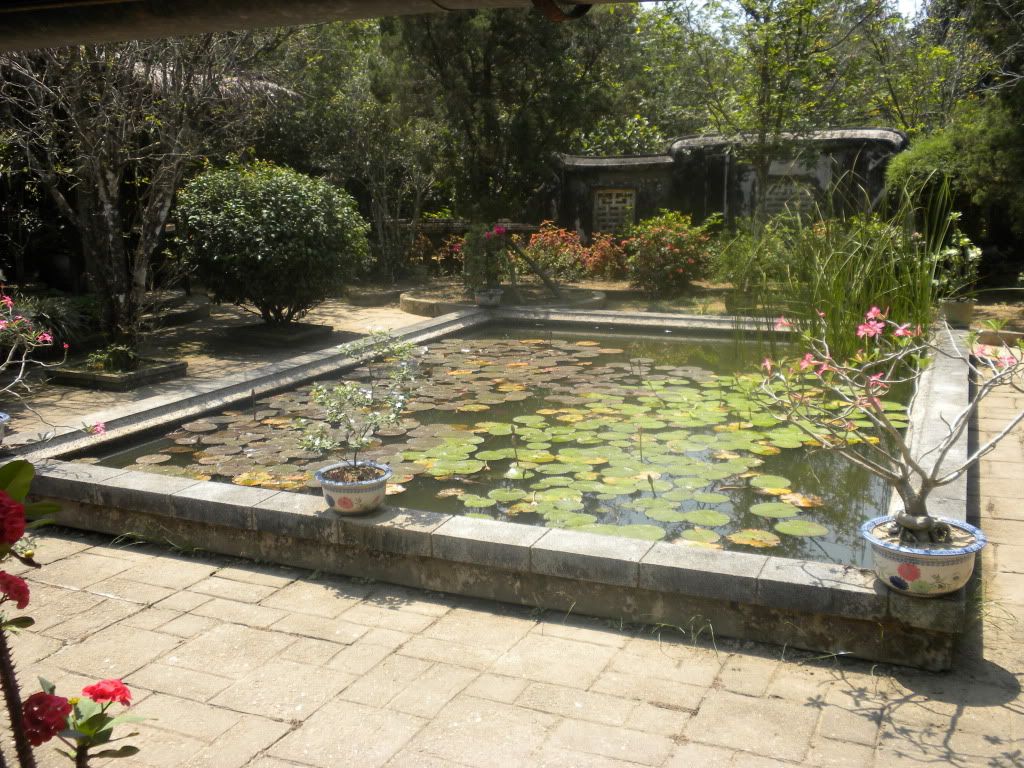
Next was the Thien Mu Pagoda, a complex of multiple buildings, the most impressive being the seven-tiered octagon-shaped Phuoc Dien Tower. According to sacred-destinations.com: “The Thien Mu Pagoda has its roots in a local legend: an old woman once appeared on the hill and said that a Lord would come and build a Buddhist pagoda for the country's prosperity. Hearing of this, Lord Nguyen Hoang ordered the construction of the pagoda of the "Heavenly Lady" (Thien Mu).” We looked around at the large guardian statues with real facial hair, the beautiful water views, and the graveyard towards the back. Henk and I walked around the complex, ended up catching the end of another tour group, as our group leader had let us all wander off on our own.
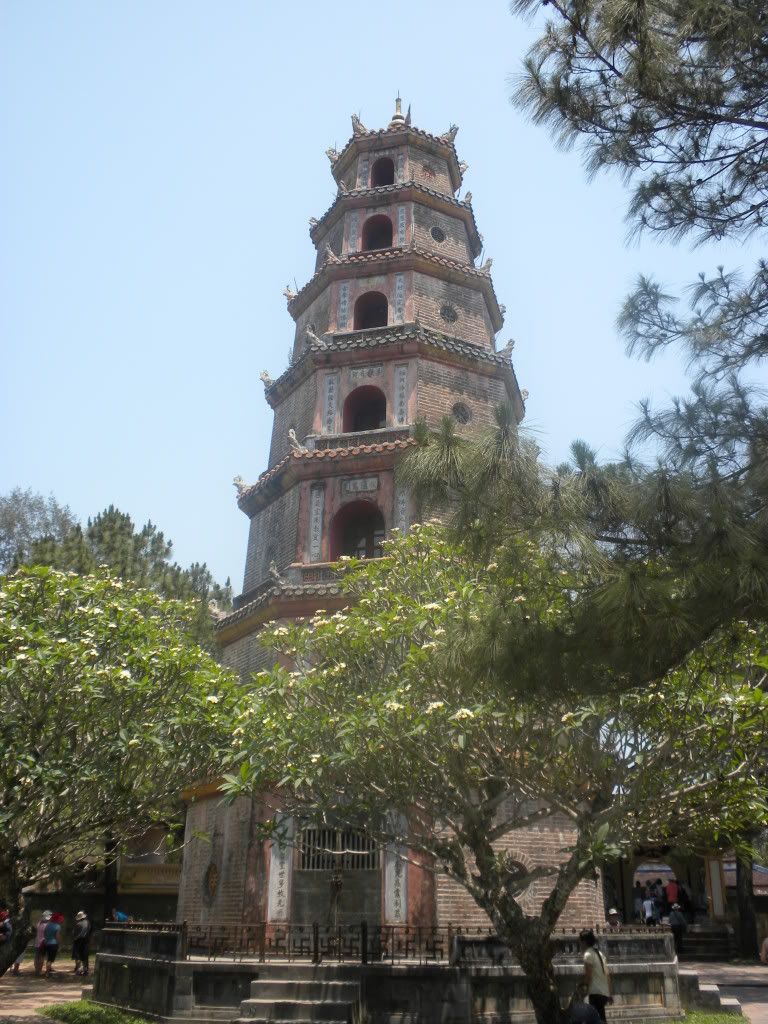
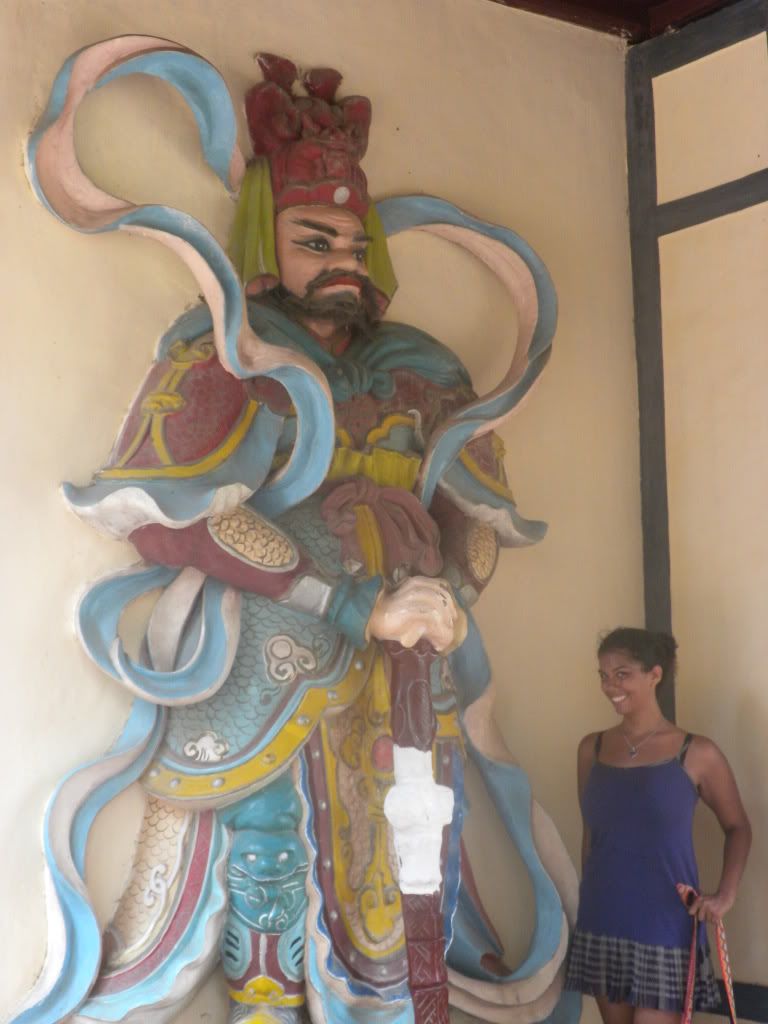
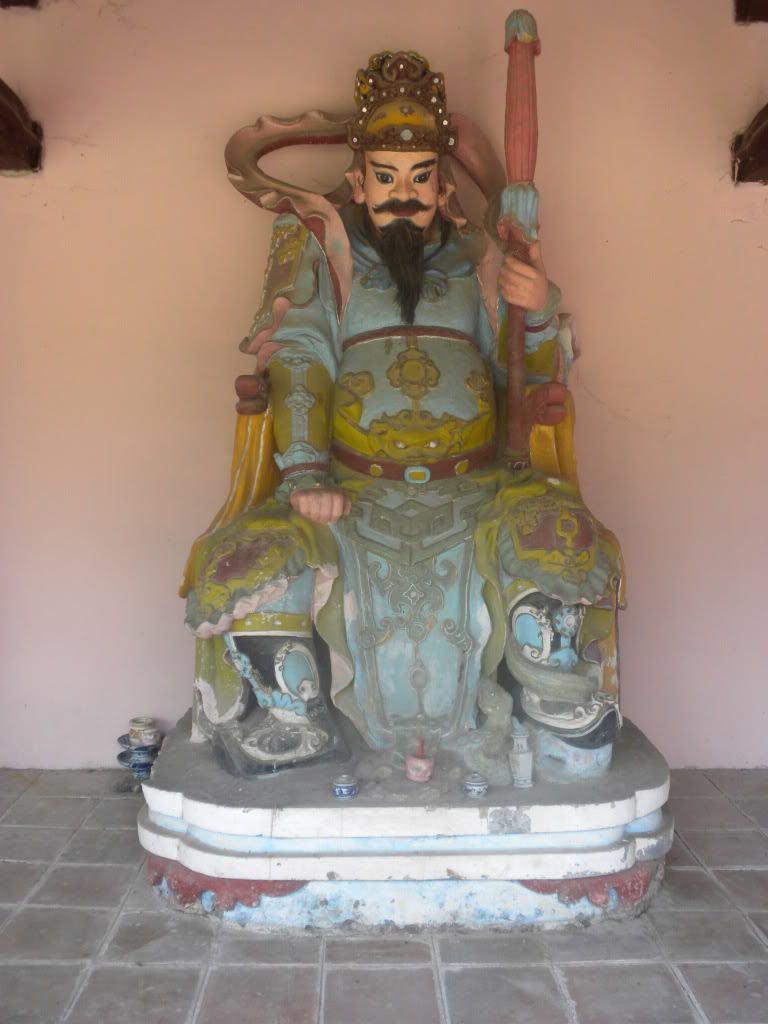
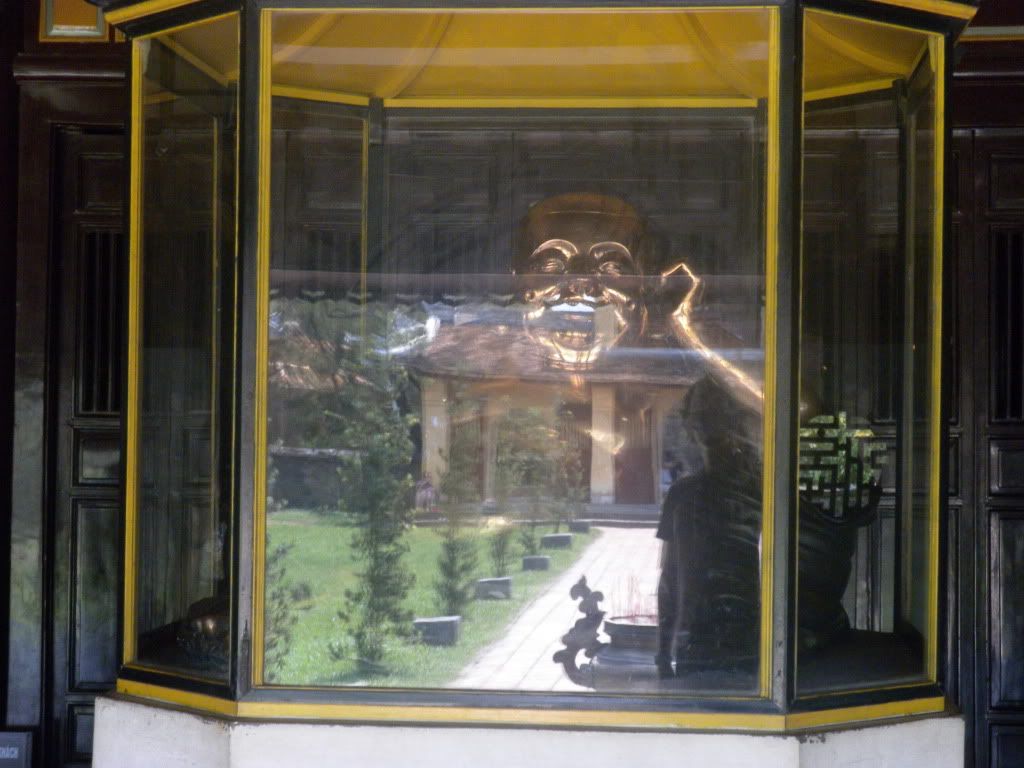
We heard this tour guide’s explanation of the car in front of us. This car, we learned, was that of Thich Quang Duc. I’m sure many of you are familiar with him without being aware of it. Below is the infamous photograph of his suicide. To the Wiki: “Thich Quang Duc was a Vietnamese Mahayana Buddhist monk who burned himself to death at a busy Saigon road intersection on 11 June 1963. (He) was protesting against the persecution of Buddhists by South Vietnam's Ngo Dinh Diem administration.” The car we were currently standing in front of is the car from the picture; the very car he drove to the scene.
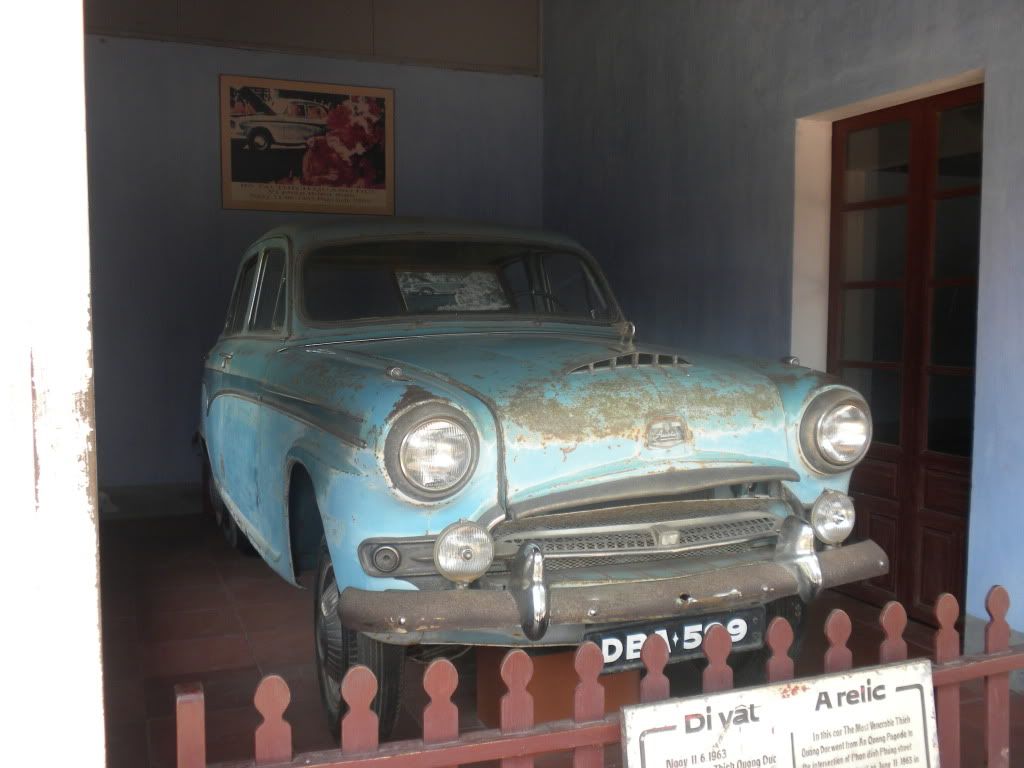
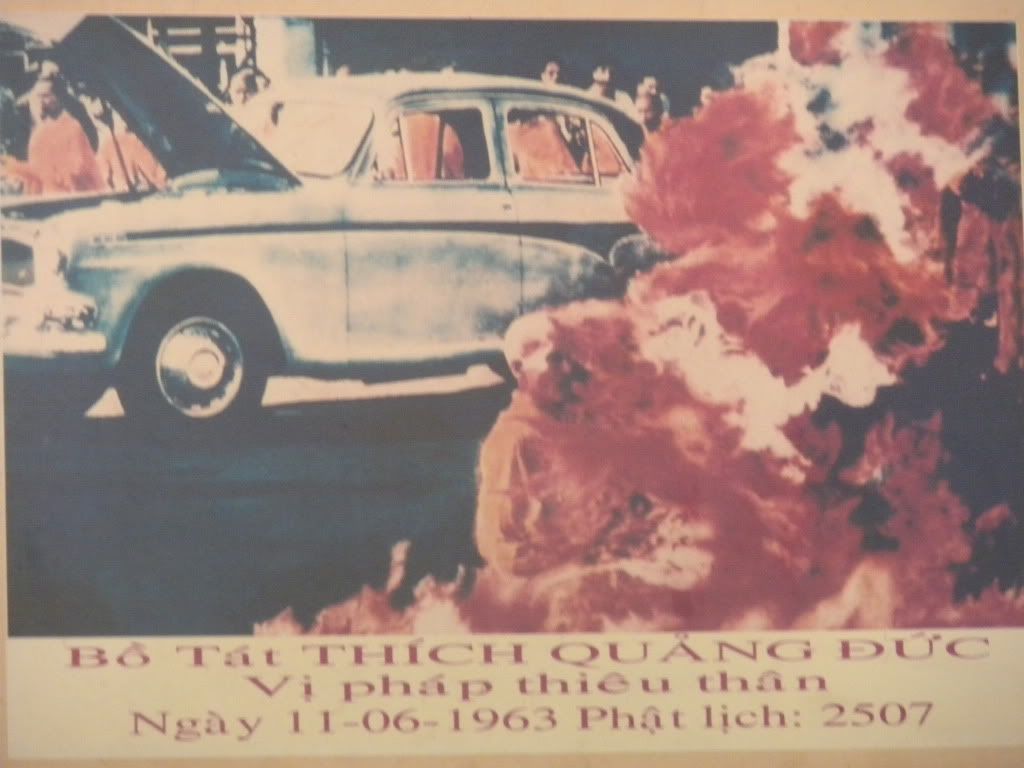
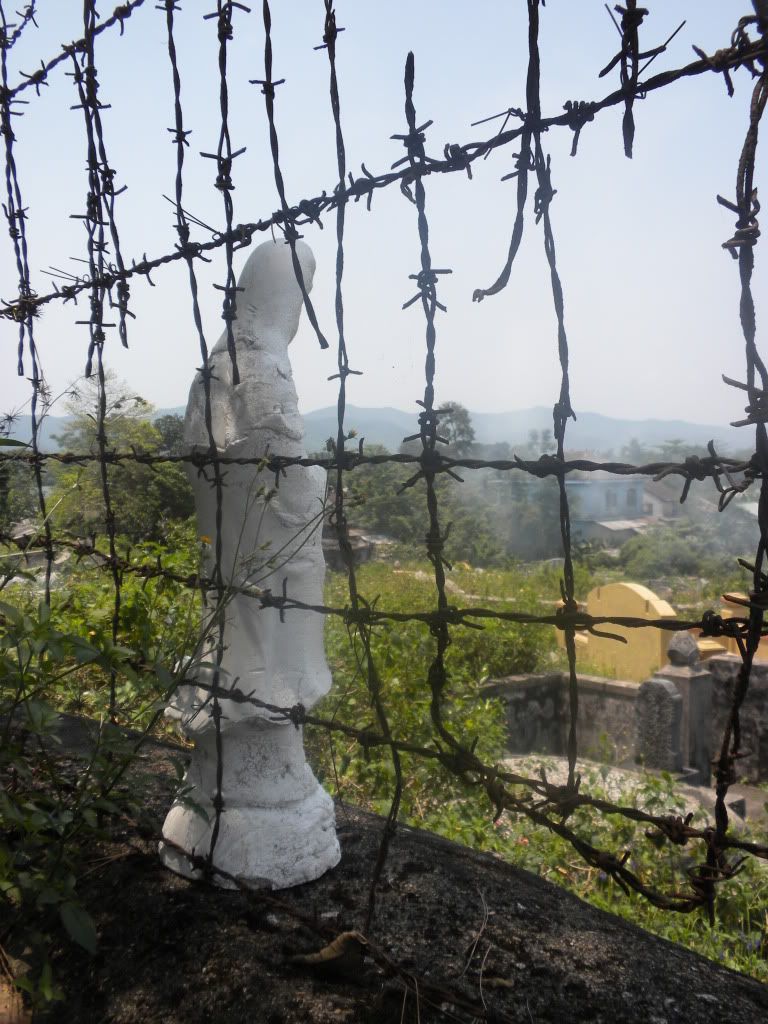

By now it was nearly noon and we were getting hungry. Thankfully our lunch stop at the ‘Stop-and-Go’ café was scheduled next and we dined on a buffet of local Vietnamese food while chatting with a Vietnamese couple visiting from Australia. Left on our day trip of Hue city was our visit to the tombs. There are three possible tombs to see, but since the entrance is rather expensive (and the tombs large) most people end up seeing just two. Our guide recommended for us to see the more traditional tomb of Emperor Minh Mang and for a contrast the more modern, Western-inspired tomb of Emperor Khai Dinh.
First we explored the traditional tomb of Emperor Minh Mang. Reigning during the early 1800’s, Minh Mang was: (go, Wiki!) “…well known for his opposition to French involvement in Vietnam and his rigid Confucian orthodoxy. As Gia Long aged, he took on a more isolationist foreign policy, and as a result favored Minh Mang especially for his outlook. Minh Mang was a classicist who was regarded as one of Vietnam's most scholarly monarchs. He was known as a poet and was regarded as an emperor who cared sincerely about his country and paid great attention to its rule, to the extent of micromanaging certain policies.”
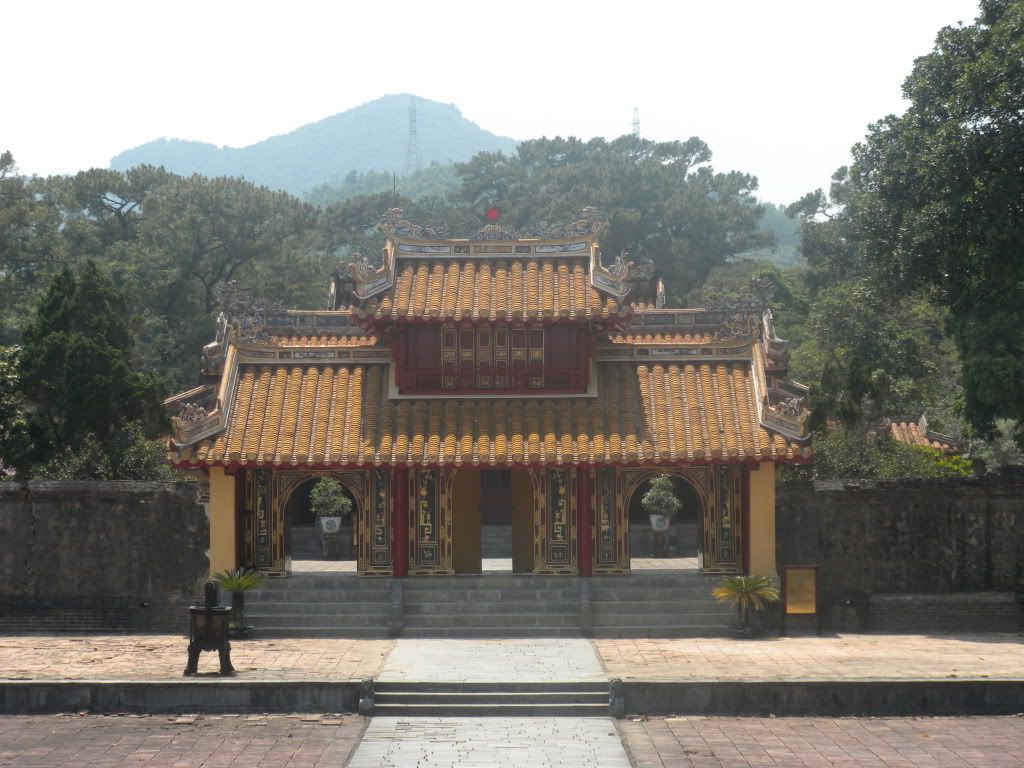
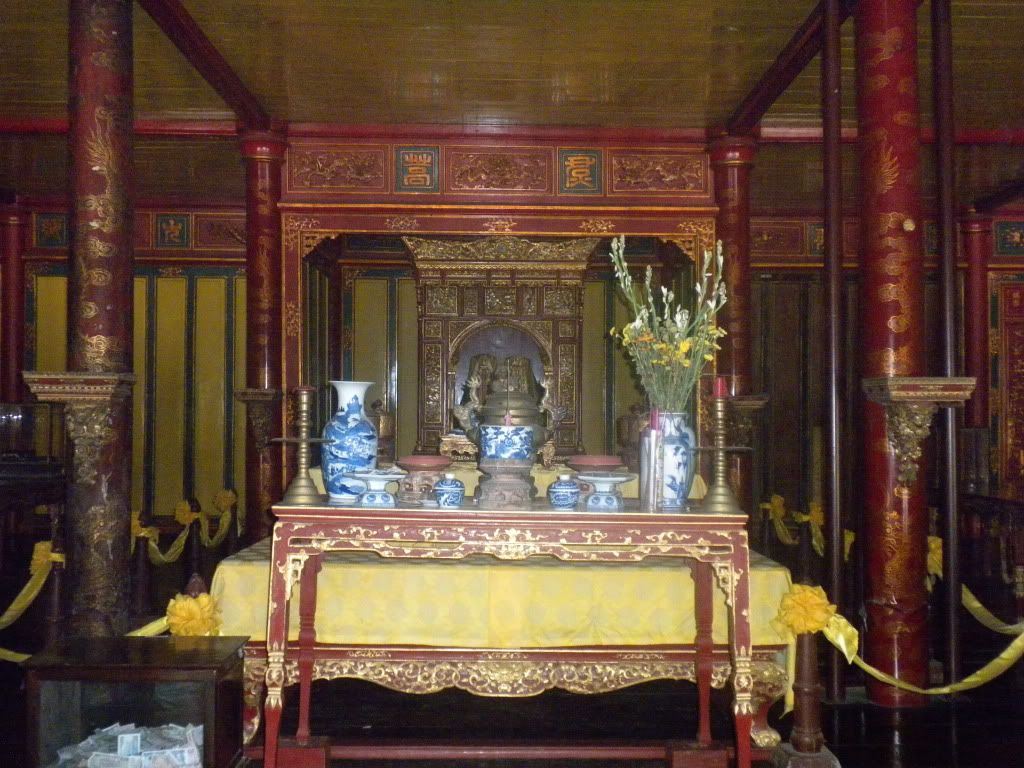
Minh Mang’s tomb has three gated entrances, the middle of course for his personal use. This central gate was known as the Hien Duc Gate, with the three-gated design typifying the aesthetic of the Nguyen Dynasty. There were right and left buildings for housing concubines towards the back of the tomb. The front of the tomb has a salutation court with stone statues of mandarins lining it. We had a bit of fun posing with these mandarins!
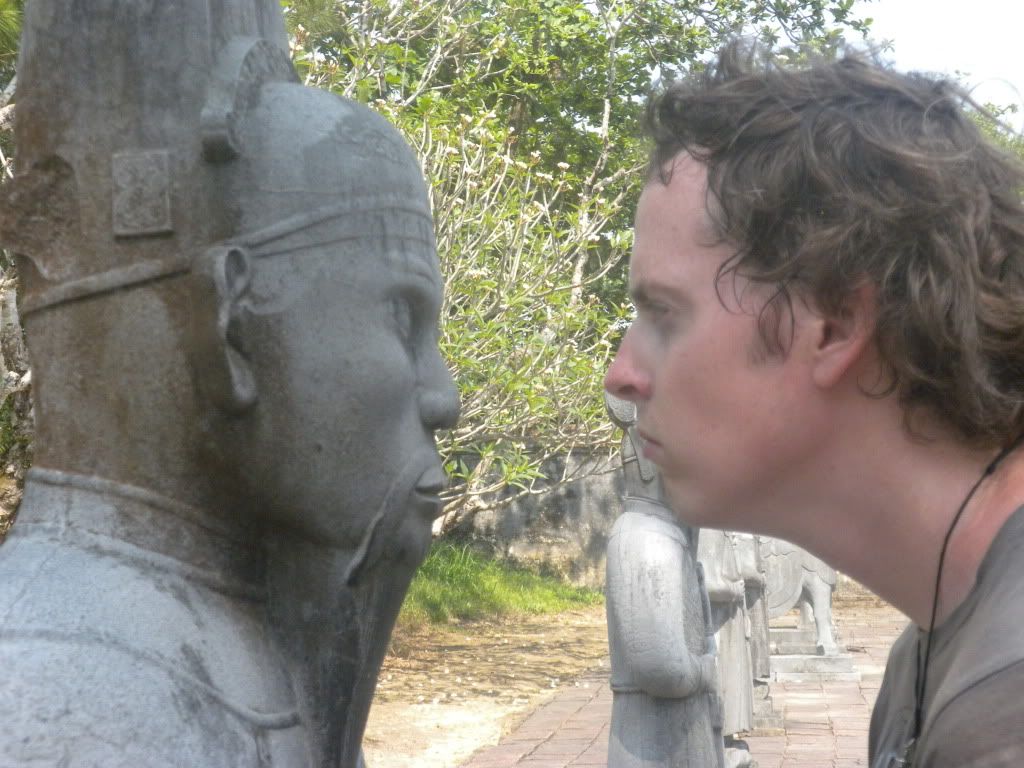
After getting our dose of traditional, we were ready for something that would really ‘Wow’ us. Emperor Khai Dinh’s tomb quite impressively filled this task. Dark yet beautifully ornate, the tomb combines Vietnamese and European elements. It uses eclectic fragments of ceramics and glass to form mosaics on the tomb’s walls. Despite the beauty of his tomb, Khai Dinh was not popular with the Vietnamese people at all. The Emperor reigned in the early 1900’s for just 9 years and was considered by many (including Ho Chi Minh) to be a puppet of the French government, attempting to legitimize their policies to his people in order to live a life of luxury himself. Khai Dinh eventually became a drug addict and died of tuberculosis in the Forbidden Purple City in 1925.
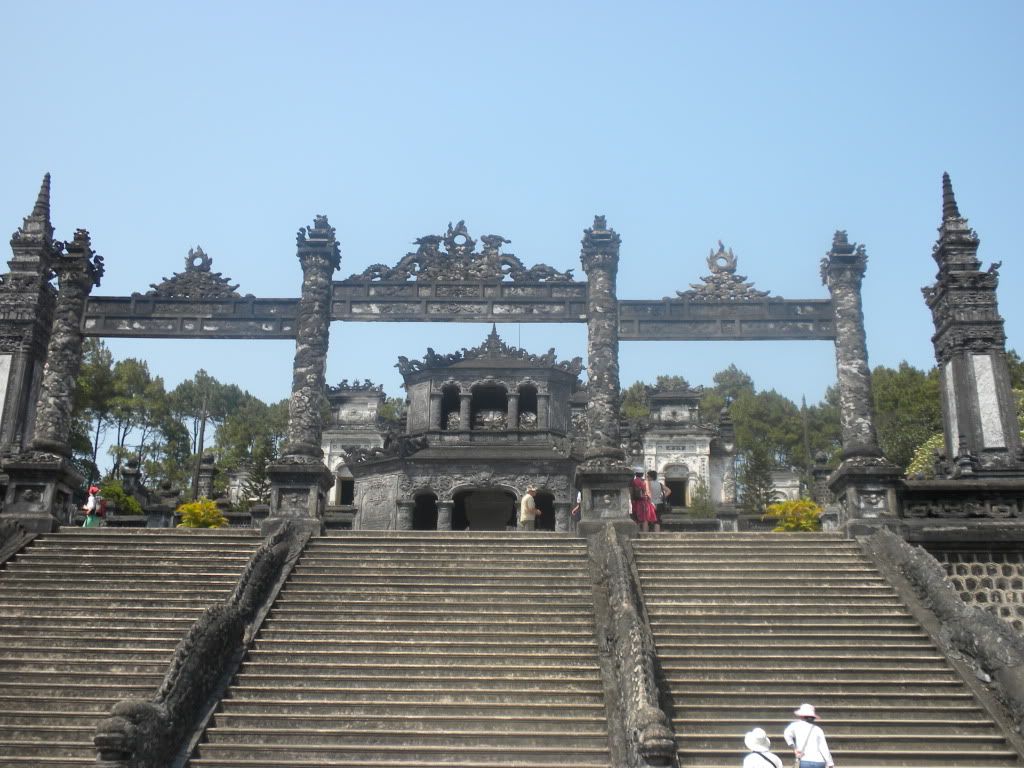

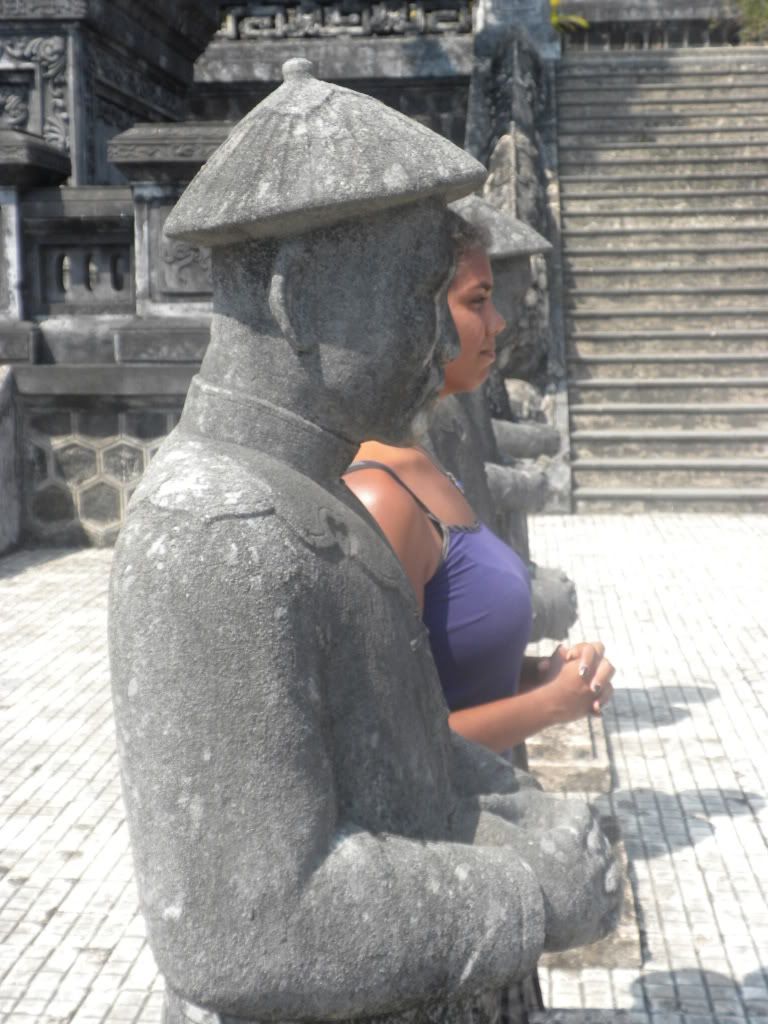
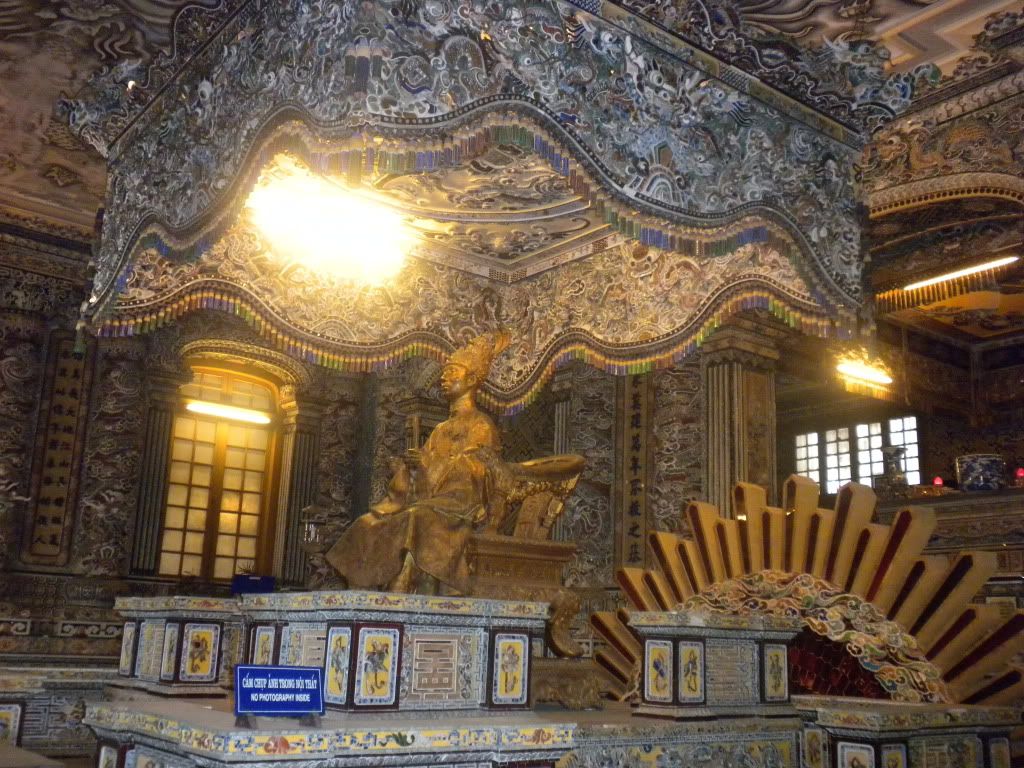
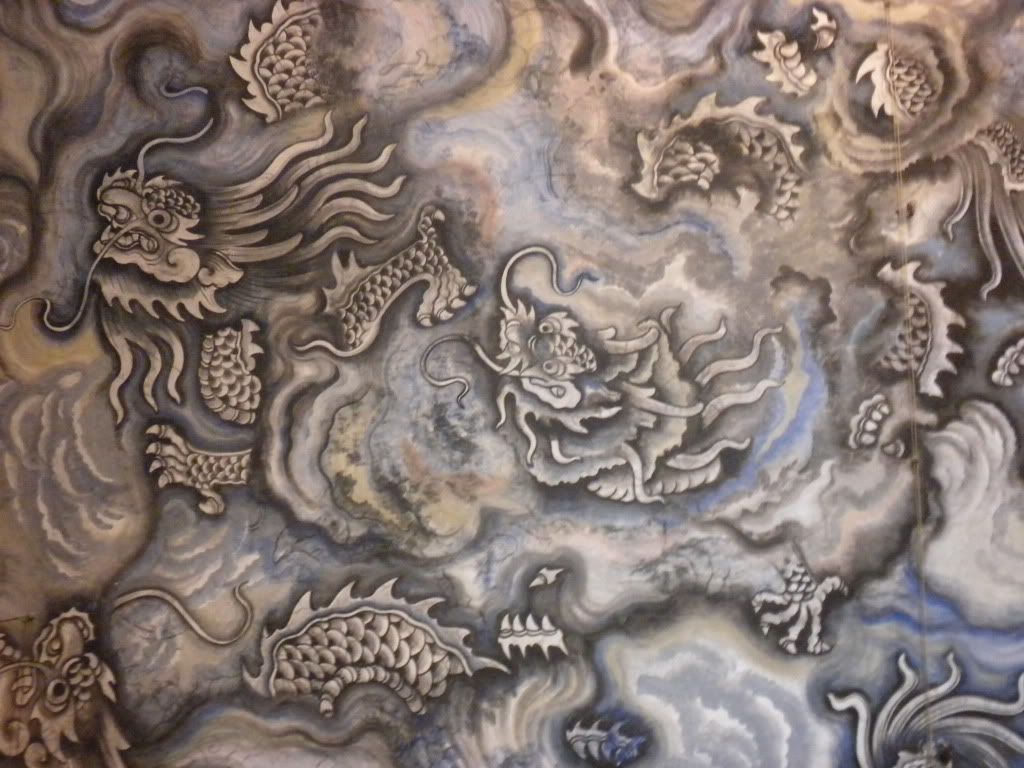

Now the tour was almost complete. The final thing on our agenda was the trip back to Hue via a boat on the perfume river. Henk and I watched the scenes around us on our return, but we also became interested in a black cat onboard the boat with us. Henk dangled the strap from our camera in front of it and we watched it go crazy trying to grab the end! Once we landed back on solid ground we headed home to our hotel, eager to get out of the heat that had been plaguing us all day. Later that evening Henk brought us some take-away and we watched some series after the long day.

Hue used to be the capital of Vietnam and the Imperial City was its palace. A walled city fortress, this area was surrounded by a boat and included the “Purple Forbidden City,” the area dedicated to housing the Nguyen royal family. The wiki can better explain some of the background of the city:
“It was in 1802 that Nguyễn Phuc Anh took control of Vietnam and proclaimed himself Emperor Gia Long. His rule was recognized by China in 1804...(A sidenote from me: The building of the Imperial City started in 1804, finished in 1833, and the city served as the center of government until 1945)… The American bombing in 1968 in response to a communist takeover of Hue flattened most of the Imperial city. Only a few buildings survived, such as the Thai Hoa Temple, Can Thanh Temple, The Mieu, and Hieu Lam Cac.”
We walked with our guide to see some of the few surviving buildings that withstand American bombs. He informed us that there are three parts to the old city: the Citadel, the Imperial City, and the Forbidden Purple City. There were also 5 entrances to the city: the middle for the king, the left for ministers, the right for military, and some further entrances for elephants. We started our exploration by walking through the Noon Gate. Upon walking closer to the buildings I noticed that many of the roof tops were decorated with a detailing of awesome faux gold coins that I just loved.



The Thai Hoa Palace area contained the king’s throne and was very pretty, decorated in red and gold. This palace area was where, according to the display plaques, the king held audiences of the Nguyen court and where he presided over ceremonies. Chinese poems were written on the walls. Many of these poems described the 4 powerful animals: the Dragon (representing the king), the phoenix (representing beauty), the turtle and the unicorn. We also looked at the throne, which is made of gold and thus very fragile and valuable.



Exiting this area, we paused for a few minutes to watch a short video on the area, showing the digitized images of what the city would have looked like if it was still standing. Next we did a quick tour of the mandarin’s offices on the left and right of the pavilion. These buildings had been used as administrative offices, national exam halls, and banquet rooms. One of the office areas is now used as a mini-museum displaying some of the artifacts from the times. It was extremely sad to walk further and see the reconstruction area towards the back of the complex -- so much work to do and so much of the original buildings lost.



After the city we had a short break of tea and snacks before heading to our next stop. After learning about the mandarins who served the king, we were now going to visit one of their former houses. The house itself proved very sturdy, made of ironwood which helps to keep spiders away (don’t ask me how, something to do with the smell they don’t like) and makes the whole place look very elegant and formal. The family alter in the center of the house was the first thing we saw entering the house, and that area combined with the beauty of the gardens outside turned the whole place into a calm oasis in the middle of Hue.


Next was the Thien Mu Pagoda, a complex of multiple buildings, the most impressive being the seven-tiered octagon-shaped Phuoc Dien Tower. According to sacred-destinations.com: “The Thien Mu Pagoda has its roots in a local legend: an old woman once appeared on the hill and said that a Lord would come and build a Buddhist pagoda for the country's prosperity. Hearing of this, Lord Nguyen Hoang ordered the construction of the pagoda of the "Heavenly Lady" (Thien Mu).” We looked around at the large guardian statues with real facial hair, the beautiful water views, and the graveyard towards the back. Henk and I walked around the complex, ended up catching the end of another tour group, as our group leader had let us all wander off on our own.




We heard this tour guide’s explanation of the car in front of us. This car, we learned, was that of Thich Quang Duc. I’m sure many of you are familiar with him without being aware of it. Below is the infamous photograph of his suicide. To the Wiki: “Thich Quang Duc was a Vietnamese Mahayana Buddhist monk who burned himself to death at a busy Saigon road intersection on 11 June 1963. (He) was protesting against the persecution of Buddhists by South Vietnam's Ngo Dinh Diem administration.” The car we were currently standing in front of is the car from the picture; the very car he drove to the scene.




By now it was nearly noon and we were getting hungry. Thankfully our lunch stop at the ‘Stop-and-Go’ café was scheduled next and we dined on a buffet of local Vietnamese food while chatting with a Vietnamese couple visiting from Australia. Left on our day trip of Hue city was our visit to the tombs. There are three possible tombs to see, but since the entrance is rather expensive (and the tombs large) most people end up seeing just two. Our guide recommended for us to see the more traditional tomb of Emperor Minh Mang and for a contrast the more modern, Western-inspired tomb of Emperor Khai Dinh.
First we explored the traditional tomb of Emperor Minh Mang. Reigning during the early 1800’s, Minh Mang was: (go, Wiki!) “…well known for his opposition to French involvement in Vietnam and his rigid Confucian orthodoxy. As Gia Long aged, he took on a more isolationist foreign policy, and as a result favored Minh Mang especially for his outlook. Minh Mang was a classicist who was regarded as one of Vietnam's most scholarly monarchs. He was known as a poet and was regarded as an emperor who cared sincerely about his country and paid great attention to its rule, to the extent of micromanaging certain policies.”


Minh Mang’s tomb has three gated entrances, the middle of course for his personal use. This central gate was known as the Hien Duc Gate, with the three-gated design typifying the aesthetic of the Nguyen Dynasty. There were right and left buildings for housing concubines towards the back of the tomb. The front of the tomb has a salutation court with stone statues of mandarins lining it. We had a bit of fun posing with these mandarins!

After getting our dose of traditional, we were ready for something that would really ‘Wow’ us. Emperor Khai Dinh’s tomb quite impressively filled this task. Dark yet beautifully ornate, the tomb combines Vietnamese and European elements. It uses eclectic fragments of ceramics and glass to form mosaics on the tomb’s walls. Despite the beauty of his tomb, Khai Dinh was not popular with the Vietnamese people at all. The Emperor reigned in the early 1900’s for just 9 years and was considered by many (including Ho Chi Minh) to be a puppet of the French government, attempting to legitimize their policies to his people in order to live a life of luxury himself. Khai Dinh eventually became a drug addict and died of tuberculosis in the Forbidden Purple City in 1925.






Now the tour was almost complete. The final thing on our agenda was the trip back to Hue via a boat on the perfume river. Henk and I watched the scenes around us on our return, but we also became interested in a black cat onboard the boat with us. Henk dangled the strap from our camera in front of it and we watched it go crazy trying to grab the end! Once we landed back on solid ground we headed home to our hotel, eager to get out of the heat that had been plaguing us all day. Later that evening Henk brought us some take-away and we watched some series after the long day.


0 Comments:
Post a Comment
<< Home